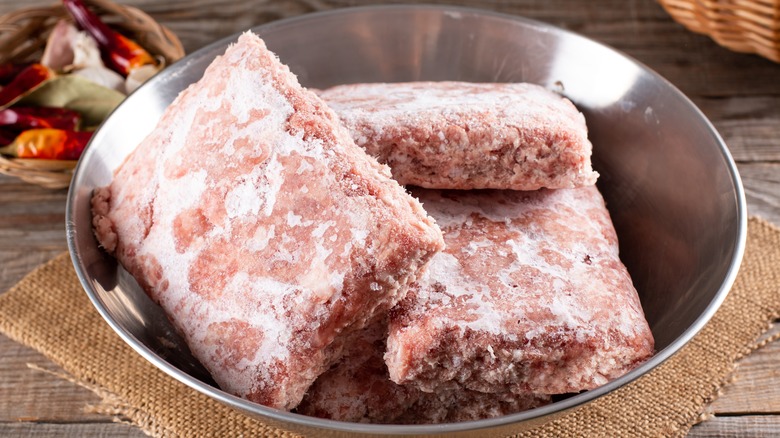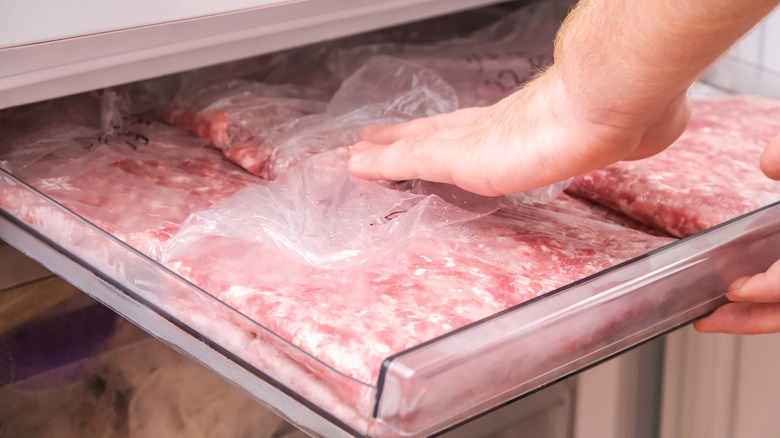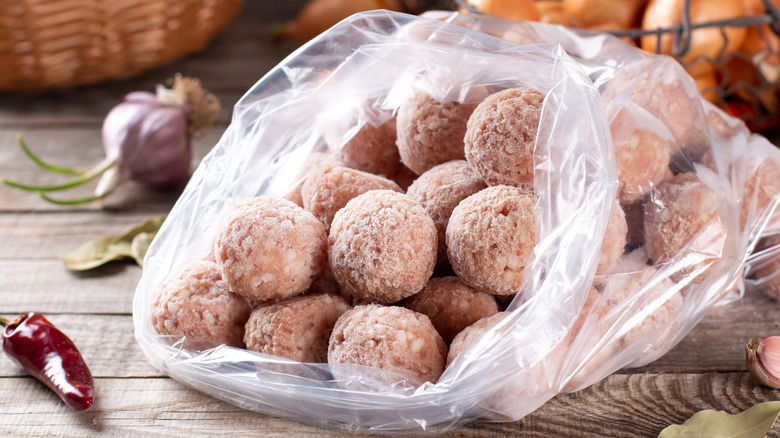The Most Important Thing To Know When Refreezing Ground Beef
Like other raw meats, ground beef can spoil quickly and should be handled with extra caution. According to the U.S. Department of Agriculture (USDA), this type of meat is particularly vulnerable to E. coli contamination, a bacterium that can survive cold temperatures. Additionally, it can become contaminated with Salmonella, Staphylococcus aureus, and other pathogens during handling and storage. To stay safe, you should freeze it or store it at 40 degrees Fahrenheit for no more than two days and then cook it at 160 degrees Fahrenheit or higher.
Defrosting ground beef is relatively easy — you can thaw your meat in the microwave, leave it in the refrigerator, or submerge it in cold water. As a rule of thumb, don't leave it at room temperature or thaw it in hot water. Also, it's safe to refreeze uncooked ground beef, but only if it was initially thawed in the fridge. Note that most foods, including ground meat, lose moisture through thawing, which can affect their quality.
The right way to refreeze thawed ground beef
Buying ground beef can be tricky, given the risk of bacterial contamination. However, freezing and thawing it is even more challenging. The USDA warns that bacteria can grow and spread quickly at temperatures between 40 and 140 degrees Fahrenheit, and, therefore, you should never leave the meat on the countertop for longer than one or two hours. The same can happen if you thaw the meat in the microwave or in cold water and then refreeze it.
As previously mentioned, it's safe to refreeze ground beef that has been thawed in the refrigerator, according to the USDA. Just make sure it doesn't stay longer than one or two days in the fridge. If you thawed the meat in the microwave or in cold water, cook it thoroughly before freezing it to kill harmful bacteria. All in all, you can refreeze partially or fully thawed meat that's still cold to the touch.
Repeatedly thawing and freezing ground beef can alter its quality. Given this aspect, it's best to cook your meat after thawing it instead of putting it back in the freezer. For example, you could make ground beef with onions and peppers for a quick, light dinner. If you have a large package of ground beef, use it for meatloaf, casseroles, stuffed peppers, or shepherd's pie.
How to safely refreeze cooked ground meat
Refreezing cooked ground beef is safe as long as you take proper precautions. First, let it cool down on the countertop. Next, divide it into small portions and place them in airtight containers or freezer bags. If, say, you cook burgers on the grill, it's okay to freeze and refreeze them a couple of times. Wrap each burger in plastic foil, and then place the patties in a freezer bag.
As a general rule, refreeze the burgers or other dishes made with ground beef within two days of thawing and eat them over the next four months. Note, though: if the meat was left out at room temperature for more than two hours, it may no longer be safe to eat. This applies to most cooked foods, including meat, fish, pasta, veggies, tofu, and dairy. At room temperature, a single bacterium can multiply by over two million within seven hours. The risks are even higher if you leave your food out at a temperature above 90 degrees Fahrenheit for longer than one hour.
Beware that, just like raw meat, cooked ground beef may become less palatable if you thaw and refreeze it. Therefore, it's best to eat it in a timely manner and only cook as much as you need. Another option is to use up your leftovers instead of repeatedly freezing them. For example, you can repurpose leftover steak into beef stroganoff, stews, tacos, fajitas, or chili con carne.


